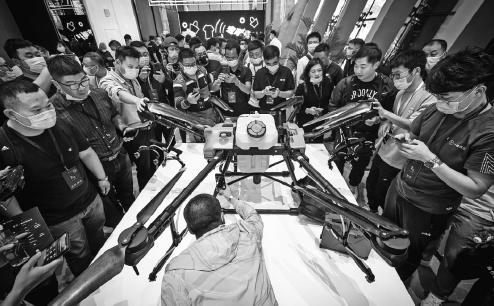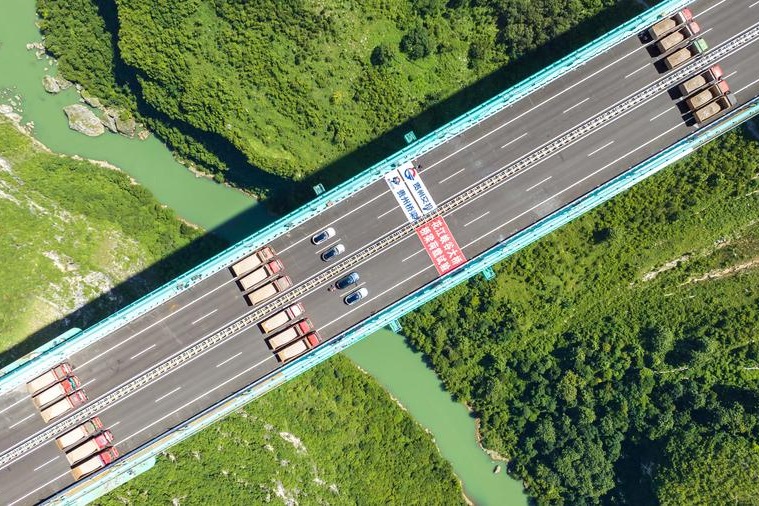Drones take drudgery out of farmwork
Sowing seeds, spreading fertilizers and pesticides increasingly done remotely

Aerial drones appeared one recent early morning above the Honghe Hani Rice Terraces in Southwest China's Yunnan province in an area where the elderly form the backbone of local agricultural cultivation.
Li Zhenglin, a farmer in his 60s, gazed down from a hillside and watched the agricultural-use drones buzz through the air and spread seeds during the rice planting season. With the advent of drones, he can finally bid farewell to the days of trekking up and down the steep slopes in the mountainous area.
In the past, Li had to rely on manpower to seed, sprinkle fertilizers and spray pesticides-tasks that are exhausting, time consuming and inefficient. But now a group of tech-savvy young people have brought farm drones to help villagers like Li boost productivity and profits.
"It took up to one day to manually spray fertilizers on only 0.3 hectare of rice terrace. But now the same amount of work can be completed by one drone in five minutes," he said.
With the modernization of agriculture, demand for advanced farming devices has been growing significantly in China. Data from the Shenzhen, Guangdong province-based Qianzhan Industry Research Institute said the value of the domestic agricultural drone market will exceed 12.8 billion yuan ($1.96 billion) by 2021, representing a compound annual growth rate of 38 percent.
The government has implemented policies to promote the use of modern agricultural machines and offers subsidies to encourage the use of drones on farms.
DJI, the world's largest commercial drone manufacturer by market share, has invested heavily to develop agricultural drones, with the goal of helping farmers improve efficiency and increase the usage ratio of intelligent agricultural equipment.
Chen Tao, global marketing and sales director of DJI's agricultural equipment department, said the company's agricultural drones have worked on around 33 million hectares this year, more than double the area covered last year. The company sold more than 40,000 drones for agricultural use this year.
The Shenzhen-based company has also expanded its footprint in international markets, especially in Southeast Asia and Latin America, which have shown great growth potential, Chen said, adding that overseas sales doubled this year despite the negative impact of the COVID-19 pandemic.
"In recent years, smart-technology equipment in the form of farm drones has continued to help farmers increase revenue and cut costs," Chen said, adding that DJI will continue to put more resources, build digital agriculture solutions based on spatial intelligence solutions with partners, help farmers improve farmland management and provide new solutions for China's agricultural development.
Chen said DJI hopes to attract more young people, especially those in rural areas, to use agricultural-use drones and start up related businesses. "We have also invested more than 200 million yuan in agriculture after-sales services this year."
The COVID-19 pandemic has promoted the application of unmanned agricultural machinery and equipment to some extent, which is a big boost for the drone industry, Chen added.
In November, DJI launched its new agricultural drone products, the T30 and T10, which feature dynamic systems to increase work efficiency and accuracy.
Drone operators who use T30 drones equipped with updated barrier-avoidance radar systems and dual cameras can spray pesticides over about 16 hectares of farmland an hour, 33 percent more compared to the previous generation of aerial drones.
Priced at 19,999 yuan, T10 is the cheapest among DJI's agricultural drones. Small and lightweight, the drone can be used for smaller plots more common in South China by small and medium-sized farm owners.
The company is bullish on prospects for agricultural drones as demand for such gadgets is huge and the whole industry is still in an exploratory mode.
DJI's agricultural-use business began in November 2015 when it launched its first such drone, the MG-1, marking its diversification into the segment. It unveiled an upgraded agricultural drone, the MG-1S, in 2016 and the MG-1S Advanced in 2017, with upgraded flight control systems, radar capabilities and sensors.
In 2018, it launched the T16, which features an upgraded loading capacity, and the T20 in 2019.
Chen Shengdou, director of the China Agro-tech Extension Association, said farm drones are being used to safeguard a wide range of crops. He added that farmers have high expectations for modern agricultural equipment, which plays a critical role in prompting the transformation, upgrade and development of traditional agriculture.
China's largest agricultural drone maker-XAG Co Ltd-has stepped up efforts to develop drones and self-driving utility vehicles for use on farms in an attempt to introduce digital agricultural solutions and build smart farming ecosystems.
Last month, the company announced it completed a 1.2 billion yuan round of financing led by Baidu Capital and SoftBank Vision Fund 2, and subsequently followed by Sinovation Ventures, Guangzhou Yuexiu Industrial Investment Fund Management and Guangzhou Emerging Industry Development Fund.
This is so far the largest commercial financing in China's agri-tech sector.
Peng Bin, CEO and founder of XAG, said the company will enhance research and development, boost manufacturing and service capabilities, enrich sales channels and accelerate the construction of digital agricultural infrastructure with the proceeds from this round.
The domestic sales volume of its drones is expected to rise to 50,000 units in 2020 from 25,000 in 2019, said Justin Gong, co-founder of the Guangzhou, Guangdong province-based company XAG.
He said agriculture is now facing great challenges, such as an aging rural population and a lack of farmhands. Also, in China some 12 million people move from rural areas to cities every year, and they are increasingly unwilling to take over tedious, laborious farmwork from their parents.
"We develop agricultural drones, farming robots, the internet of things systems and smart agriculture farm management software to conduct fieldwork as tedious and laborious as seeding, spraying pesticides and crop inspections," said Gong.
He said younger farmers are now able to focus more on managing agricultural inputs and making decisions to optimize production workflows.
The total number of agricultural drones in China will grow to 1 million units within the next five years, Gong said, adding that China is at the forefront of not only farm drone manufacturing but their myriad applications.
"Our ultimate goal is to create a smart agriculture ecosystem in which all the repetitive, tedious and dangerous jobs are handed over to drones and robots, allowing farmers to focus on the process of decision making with the aid of big data and artificial intelligence," Gong added.
"During this critical pandemic period, we launched an online program that trained farmers to become drone operators. And we also worked with seed companies to develop special coatings for rice seeds that could be directly spread by our drones," Gong said.
So far, XAG had introduced agricultural drones to more than 9.31 million farmers and serviced 52 million hectares of farmland.
China has 120 million hectares of arable land, and 300,000 agricultural drones are needed to meet the requirements of modern agricultural development, said Wang Zhiguo, director of the National Aviation Plant Protection Science Technology Innovation Alliance.
Yang Jincai, director of the Shenzhen Unmanned Aerial Vehicle Industry Association, said: "Drones are playing a vital and positive role in the fight against the spread of coronavirus, including spraying disinfectants, logistics and distribution, and delivering critical supplies."
Yang added that the domestic civil drone market has huge growth potential, with surging demand from agriculture, cargo transportation and wireless network data activities.
































